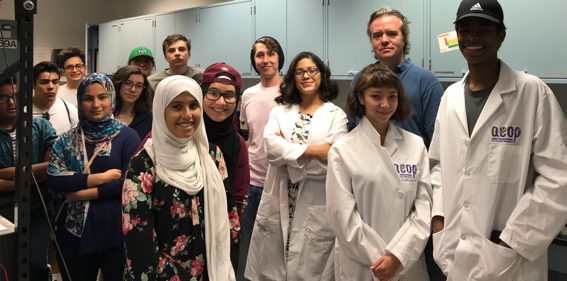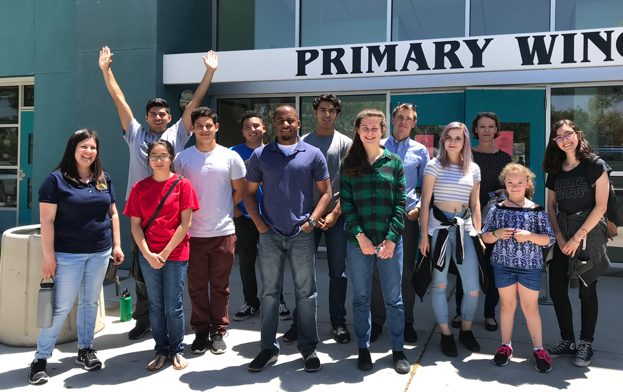Recent News
NQVL Design Phase Award
October 1, 2025
CHTM Joins NSF's NQVL Pilot Projects
August 9, 2024
OSE PHD, Dr. Xuefeng Li - Wins The Outstanding Interdisciplinary Graduate Programs Award
May 10, 2024
Dr. Ali Rastegari - 2024 OSE Best Dissertation Award Winner
May 10, 2024
News Archives
Internships at CHTM Offer Unique Research Experiences
November 1, 2018 - Stefi Weisburd
Maya Garcia cheerfully nods to the research engineering tech in his “bunny suit" as she scans the shelves of supplies, noting that the storeroom is running low on nitrile gloves, tweezers, and face masks. She proceeds to enter orders for these in the computer with a short interruption to sell a supply item to a cleanroom user. She has just walked over to CHTM after her classes at Albuquerque Institute for Mathematics and Science (AIMS) where she is an 11th grader. Not your typical pizza parlor after-school job for this high school student. Maya is one of a handful of pre-college students working in labs at CHTM during the academic year. She was part of a larger cohort working on research projects during the summer.

NASCENT ERC graduate student Neal Wostbrock and high school student Maya Garcia.
"The experience I had at the Center for High Technology Materials has been the most immersive and rewarding intellectual endeavors I have participated in,” says Garcia who worked with the NASCENT Engineering Research Center (ERC) group in Dr. Tito Busani’s lab. During the summer she learned about nanoparticle fabrication, and with the help of her graduate student mentor Neal Wostbrock, she designed and 3D-printed a photolithography demonstration project that she will present to fellow AIMS students during the AIMS Science Fair.
Though graduate, and to a lesser extent undergraduate, students make up the majority of CHTM researchers who helped propel UNM to one of the top 100 research universities in the world, high school students have also had a consistent place in the CHTM research family. Most students come from Albuquerque, but some have come from as far as Las Cruces and Farmington.
Nikita Dougan, a Junior at Early College Academy, is extending his summer internship under the U.S. Army Research Engineering Apprenticeship Program (REAP) in Dr. Marek Osinski’s lab into the fall. He and his mentor are devising Polymerase chain reaction (PCR) protocols to detect two kinds of mouth bacteria for experiments that will use nanoparticles in mouth wash to kill bacteria. Dougan was one of four REAP researchers in Dr. Osinski’s lab last summer.

Three REAP students (in lab coats) give a lab tour to a UNM School of Engineering camp last summer.
High school interns often thrive under the thoughtful guidance of graduate student and faculty mentors. They immediately see the relevance of their course work as it is put in a real-world context. They develop many skills, from how to record and analyze data to non-cognitive attributes such as teamwork, persistence and how to be comfortable talking to professors. “I entered this [program] scared and nervous, but now I know that if I put in the right amount of effort, I can accomplish whatever I set my mind to,” says Thomas Baca, an Albuquerque High School student who worked in Dr. Ganesh Balakrishnan’s QESST ERC solar cell laboratory last summer.
Some students have continued their research in CHTM labs as UNM undergraduates. Although she is now a Sandia student employee, former Manzano High School student Amy Soudachanh extended her high school research in the Balakrishnan QESST ERC lab as a UNM physics undergraduate for over a year, and she still participates in QESST outreach (see photo). She credits the QESST program at UNM with giving her an opportunity for success that her family and the public schools were unable to provide.
CHTM research experiences have prompted some students to reconsider going out of state for college. “The environment at CHTM changed my mind about UNM, and now I am seriously considering it as one of my options for school,” notes Garcia.
For others, CHTM lab internships helped launch academic careers at Ivy league and other universities.

Interns do outreach too! Included above in this photo taken after outreach to the Albuquerque Public Schools Title 1 Homeless Project last summer are one former QESST intern, two QESST high school interns, one NASCENT intern, two CISTAR ERC interns, two visiting QESST undergraduates, a QESST teacher, a postdoc, one graduate student and two volunteers from the public. The CISTAR ERC does not have any labs at CHTM.
The QESST internship “definitely prepared me for the college environment and high-level academic work,” says Adrian Armendariz, now a Mechanical Engineering major at the University of Pennsylvania and a former Atrisco Heritage Academy High School valedictorian. He helps incoming UPenn freshmen with backgrounds similar to his own adjust to college life. Armendariz returned to CHTM last summer as an undergraduate research in Dr. Francesca Cavallo’s laboratory, while his younger brother David (another Atrisco Valedictorian now at USC Engineering) found a research internship in Dr. Christina Salas’s lab. Last summer Dr. Cavallo also hosted the younger sister of Sophia Sanchez-Maes, a former CHTM intern and current Yale student. Currently, Dr. Cavallo is working with two South Valley Academy students.
Students interested in applying for the REAP program in Dr. Osinski’s lab should apply here: https://www.usaeop.com/program/reap/. Applications for next summer will be available November 1 – February 28.
Students interested in ERC internships should keep an eye on this website: https://engineering.unm.edu/outreach/k-12-programs/high-school-programs.html.
Highland High School students interested in internships next summer may send resumes, transcripts and/or letters of interest to Dr. Terefe Habteyes at habteyes@unm.edu.


